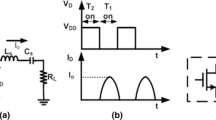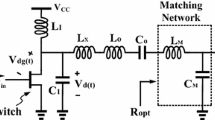Abstract
This work studies the effects of the drain pn capacitance grading coefficient, duty cycle and supply modulation on the operation of class E amplifier. The class E operation analysis with a combination of nonlinear and linear output capacitances is revisited and duty cycle is added to the equations to allow further investigations for optimum class E circuit tuning. The presented analysis method can be used for synthesis as well, where necessary load components are calculated for a transistor with a specific grading coefficient both in the output capacitance and in the nonlinear feedback capacitance. Further, the grading coefficient of the nonlinear output capacitance is varied in the paper while investigating the changes in normalized peak voltages and harmonics. Drain efficiency, supply-to-amplitude modulation (V dd /AM) and supply-to-phase modulation (V dd /PM) are studied. It is shown that by varying the device duty cycle, one can scale the optimum load and the level of peak voltages over the switching device. Also, the choice of grading coefficient affects the drain efficiency, V dd /AM and V dd /PM behaviour of the class E amplifier. Last, a case study about increasing the efficiency of a class E amplifier with hyperabrupt output junction capacitance is shown.

















Similar content being viewed by others
References
Sokal, N. O., & Sokal, A. D. (1975). Class E—A new class of high-efficiency tuned single-ended switching power amplifiers. IEEE Journal of Solid-State Circuits, 10(3), 168–176.
Raab, F. (1977). Idealized operation of the class E tuned power amplifier. IEEE Transactions on Circuits and Systems, 24(12), 725–735.
Chudobiak, M. J. (1994). The use of parasitic nonlinear capacitors in class E amplifiers. IEEE Transactions on Circuits and Systems I: Fundamental Theories and Applications, 41(12), 941–944.
Alinikula, P., Choi, K., & Long, S. I. (1999). Design of class E power amplifier with nonlinear parasitic output capacitance. IEEE Transactions on Circuits and Systems II: Analog and Digital Signal Processing, 46(2), 114–119.
Suetsugu, T., & Kazimierczuk, M. K. (2004). Analysis and design of class E amplifier with shunt capacitance composed of nonlinear and linear capacitances. IEEE Transactions on Circuits and Systems I: Regular Papers, 51(7), 1261–1268.
Mediano, A., Molina-Gaudo, P., & Bernal, C. (2007). Design of class E amplifier with nonlinear and linear shunt capacitances for any duty cycle. IEEE Transactions on Microwave Theory and Techniques, 55(3), 484–492.
Sekiya, H., Arifuku, Y., Hase, H., Lu, J., & Yahagi, T. (2005). Design of class E amplifier with any output q and nonlinear capacitance on mosfet. In Proc. European Conf. Circuit Theory and Design (Vol. 3).
Sekiya, H., Sagawa, N., & Kazimierczuk, M. K. (2010). Analysis of class de amplifier with nonlinear shunt capacitances at any grading coefficient for high q and 25% duty ratio. IEEE Transactions on Power Electronics, 25(4), 924–932.
International Rectifier. Spice models for devices. [Online]. Available: http://www.irf.com/product-info/models/.
Kazimierczuk, M. (1984). Collector amplitude modulation of the class E tuned power amplifier. IEEE Transactions on Circuits and Systems, 31(6), 543–549.
Suetsugu, T., & Kazimierczuk, M. K. (2007). Output characteristics of class E amplifier with nonlinear shunt capacitance versus supply voltage. In Proc. IEEE Int. Symp. Circuits and Systems ISCAS 2007 (pp. 541–544).
Suetsugu, T., & Kazimierczuk, M. K. (2010). Power efficiency calculation of class E amplifier with nonlinear shunt capacitance. In Proc. IEEE Int. Circuits and Systems (ISCAS) Symp. (pp. 2714–2717).
Kazimierczuk, M., & Puczko, K. (1987). Exact analysis of class E tuned power amplifier at any q and switch duty cycle. IEEE Transactions on Circuits and Systems, 34(2), 149–159.
Kahn, L. R. (1952). Single-sideband transmission by envelope elimination and restoration. Proceedings of the IRE, 40(7), 803–806.
Acknowledgments
This work has been supported by The Academy of Finland, Infotech Oulu Graduate School, TriQuint Semiconductor Inc., Nokia Foundation, Foundation of Tauno Tönning, Foundation of Ulla Tuominen, Foundation of Finnish Electronics Engineers and The Foundation of Riitta and Jorma J. Takanen.
Author information
Authors and Affiliations
Corresponding author
Rights and permissions
About this article
Cite this article
Hietakangas, S., Rahkonen, T. Analysis of class E amplifier with both linear and nonlinear shunt capacitance at any duty cycle, grading coefficient and supply modulation. Analog Integr Circ Sig Process 71, 245–253 (2012). https://doi.org/10.1007/s10470-011-9690-x
Received:
Revised:
Accepted:
Published:
Issue Date:
DOI: https://doi.org/10.1007/s10470-011-9690-x




